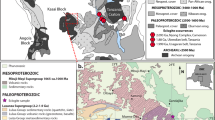Abstract
A characteristic feature of the Moldanubian part of the central European Variscides is late-orogenic high-T/low-P metamorphism. Its past history and the possible reasons for this metamorphism are highlighted by the tectonometamorphic development at the south– eastern margin of the Bohemian massif. During the Variscan orogeny, at ca. 340 Ma, two different crustal segments were juxtaposed by thrusting (the Drosendorf unit on top of the Monotonous unit). This probably marks a collisional event that is widespread in the southeastern Moldanubian zone. The collision was followed by crustal uplift accompanied by strong heating in the lowermost structural unit (Monotonous unit). During the subsequent orogenic collapse, the Moldanubian nappe pile was thrust over parts of the Moravo-Silesian terrane. A late stage of crustal extension under greenschist-facies conditions is linked with pluton emplacement. In general, magmatic underplating as well as delamination of the lithospheric mantle explains the high-T/low-P metamorphism and the large-scale plutonism in the southeastern Moldanubian zone.
Similar content being viewed by others
Author information
Authors and Affiliations
Additional information
Received: 23 January 1996 / Accepted: 28 October 1996
Rights and permissions
About this article
Cite this article
Büttner, S., Kruhl, J. The evolution of a late-Variscan high-T/low-P region: the southeastern margin of the Bohemian massif. Geol Rundsch 86, 21–38 (1997). https://doi.org/10.1007/s005310050119
Issue Date:
DOI: https://doi.org/10.1007/s005310050119




